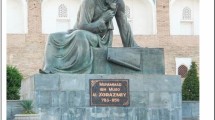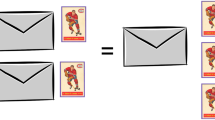Abstract
This paper examines the relationship between the historical evolution of algebraic ideas and their conceptual development. It describes a study which indicates a possible parallelism between algebraic evolution and conceptual development, and indicates how an historical analysis can guide and inform teaching.
Similar content being viewed by others
References
Boyer, C. B.: 1968, A History of Mathematics, John Wiley, New York.
Brandford, B.: 1924, A Study of Mathematical Education, Clarendon Press, Oxford.
Chomsky, N.: 1965, Essays in the Philosophy of Mathematics, Leicester University Press.
Collis, K. F.: 1975, The Development of Formal Reasoning (A Research Report), University of Newcastle (N.S.W.).
DES (Department of Education and Science): 1985. Mathematics from 5 to 16 Curriculum Matters 3, HMSO.
Freudenthal, H.: 1973, Mathematics as an Educational Task, D. Reidel, Dordrecht, Holland.
Goodstein, R. L.: 1965, Essays in the Philosophy of Mathematics, Leicester University Press.
Harper, E. W.: 1979, ‘The child's interpretation of a numerical variable’, unpublished doctorial thesis, Bath University.
Harper, E. W.: 1980, ‘The boundary between arithmetic and algebra: Conceptual understandings in two language systems, Int. J. Math. Ed. in Sci. & Technol. 11, 237–243.
Harper, E. W.: 1981, ‘Psychological changes attending a transition from arithmetical to algebraic though’, Proc. Int. Conf. P.M.E. Grenoble, France 1981
Klein, J.: 1968, Greek Mathematical Though and the Origin of Algebra, MIT press, Cambridge, Mass.
Kuchemann, D. E.: 1978, ‘Children's understanding of numerical variables’, Mathematics in School, 7,4, and 7,5.
Kuhn, T. S.: 1970, The Structure of Scientific Revolutions. Univ. of Chicago Press, Chicago.
Lakatos, I.: 1976, Proofs and Refutations, Cambridge University Press, Cambridge.
Poincaré, H.: 1908, Science et méthode, Flammarion, Paris. Authorised English translation by G. B. Halstead, The Foundations of Science, The Science Press, Lancaster, Pennsylvania, pp. 546–854.
Polya: 1962, ‘The teaching of mathematics and the biogenetic law’, in I. J. Good (ed.), The Scientist Speculates, Heinemann, London, pp. 352–356.
Russell, B.: 1927, An Outline of Philosophy, 9th imp. (1970), Allen and Unwin, London.
Streefland, L.: 1985, ‘Search for the roots of ratio: Some thoughts on the long term learning process (towards ... a theory). Part 1: Reflections on a teaching experiment’, Educational Studies in Mathematics 15(4), 327–347.
Author information
Authors and Affiliations
Rights and permissions
About this article
Cite this article
Harper, E. Ghosts of diophantus. Educational Studies in Mathematics 18, 75–90 (1987). https://doi.org/10.1007/BF00367915
Issue Date:
DOI: https://doi.org/10.1007/BF00367915




